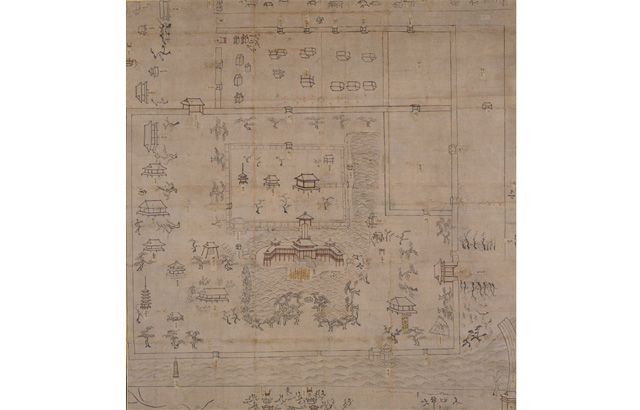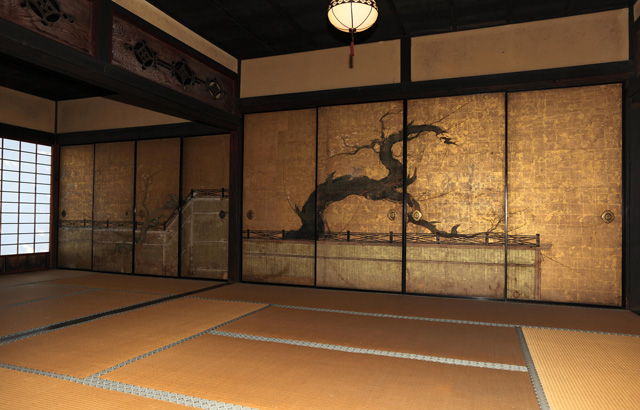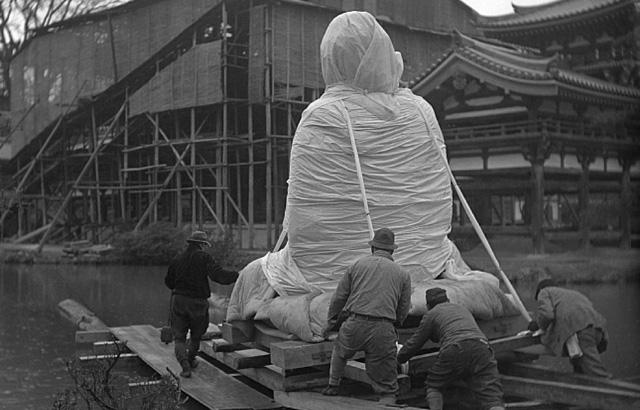In 1052, a Heian-period Regent Yorimichi Fujiwara received a villa from his father, Michinaga, and converted it into a Buddhist temple.
This is the origin of Byodoin Temple. In Buddhism, there is the Mappo “end-of-the-world” theory and it was believed that the year 1052 marked the first year of the beginning of the end-of-the-world. This theory captured the heart of many aristocrats and monks, and, as a result, people became more devout in Buddhism and believed in the Buddhist Pure Land. In the following year, Amida-do Hall (Phoenix Hall) was completed in whose interior sits the 2.4-meter-tall Amida Buddha (Amida Nyorai) created by Jocho, who is claimed to have been the very best Buddhist sculptor in the Heian period. It was at this time that Byodoin Temple reached its highest level of prosperity.
Temple buildings and Buddhist statues at Byodoin Temple with its long history of about 1,000 years, is one of the World Heritage sites of Japan.
Heian Period
- In 1052
-
In the first year of the Mappo “end-of-the-world” theory, Yorimichi Fujiwara received a villa from his father, Michinaga, and converted it into a Buddhist temple; this is the origin of Byodoin Temple.

[Statue of Yorimichi Fujiwara] Early Edo period (around 17th century); Belongs to Jodo-in Temple
- In 1053
-
As the Mappo “end-of-the-world” theory and beliefs of Buddhist Pure Land prevailed, Amida-do Hall (Phoenix Hall) which houses the Amida Buddha was established.
About Amida Buddha >>
About Phoenix Hall >>A number of buildings were constructed during this period of time,
however, most of them were lost by fires.
“Old Map of the Precinct of Byodoin Temple” Edo Period; Archived by Saisho-in Temple
- In 1180
-
As an imperial prince, Mochihito, ordered the defeat of the Heike Clan, troops led by Yorimasa Minamoto rose up and a battle broke out in Uji. However, the Minamoto troops were defeated and Yorimasa committed suicide in the precinct of Byodoin Temple. It is said to have been the first Seppuku suicide by a samurai in Japanese history and Yorimasa was later honored for showing the virtue of a samurai.

Today, the location where he committed suicide is called “Ougi-no Shiba” lawn and there is a grave of Yorimasa in the precinct.
About the Ougi-no Shiba Lawn >>
close
Medieval & Early Modern Period (Kamakura to Edo Period)
- ~1230(Early Kamakura Period)
-
Kannon-do Hall was established on the former site of the main hall.

- In 1336
-
Masashige Kusunoki, a samurai warrior who was fighting against the army of the Ashikaga Clan, set a fire around Byodoin Temple; many of the temple buildings were burnt down with only a few surviving.
- In1496
-
Jodo-in Temple was opened due to the renovation of Byodoin Temple.


- In 1640
-
Rakan-do Hall was established.

- In 1654
-
Saisho-in Temple was established.

- In 1670
-
A full-scale renovation of the Amida-do Hall (Phoenix Hall) was undertaken. The front doors were replaced.
Amida-do Hall started to become more familiar with people and became known as Phoenix Hall from around this time.
Two sub-temples, Jodo-in Temple belonging to the Jodo Sect and Saisho-in Temple belonging to the Tendai Sect, began to cooperate and made a great effort to maintain Byodoin Temple. - In 1698
-
Uji was devastated by a large fire and Byodoin Temple was badly damaged.
After this incident, the walls and doors of Phoenix Hall were ruined as a result of defacement.
close
Late Modern to Present Day(Meiji to Heisei Period)
-
As the temple became deteriorated, people's will for Phoenix Hall's preservation became enthusiastic.
- 1902~1907
-
Large-scale renovation of Phoenix Hall was undertaken in the Meiji period (1926-1989).
The Praying Bodhisattva (Buddhist Saint) on Clouds were restored. - 1950~1957
-
Large-scale renovation of Phoenix Hall was undertaken in the Showa period (1926-1989).

- 1951
-
Phoenix Hall and Amida Buddha were designated as National Treasures.
In the same year, Phoenix Hall was selected for the design of a 10-yen coin and coins were started to be used.
Then, the temple bell, the Praying Bodhisattva (Buddhist Saint) on Clouds, the canopy, Paintings on the door and walls of Cho-do Hall of Phoenix Hall were designated as National Treasures. - 1967~1972
-
For the purpose of the preservation of cultural property, “Phoenixes,” “Temple Bell,” and “Paintings on the doors and walls of Cho-do Hall of Phoenix Hall” were replaced with reproductions.
- 1990~2003
-
Maintenance on the garden, including the recreation of the Suama sandbar, was completed.

- 1994
-
Designated as a UNESCO World Heritage as one of the Historic Monuments of Ancient Kyoto
- 2001
-
Hoshokan Museum was opened.

- 2003~2007
-
Large-scale renovation on the canopy of Amida Buddha was undertaken.

- 2012~2014
-
Full-scale renovation in the Heisei period (from 1989) began.



close